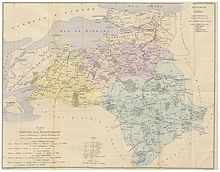Mutasarrif

Mutasarrif, mutesarrif, mutasarriff, or mutesarriff (Ottoman Turkish: متصرّف, mutasarrıf) was the title used in the Ottoman Empire and places like post-Ottoman Iraq for the governor of an administrative district in place of the usual sanjakbey.[1][2] The Ottoman rank of mutasarrif was established as part of a 1864 reform, and its holder was appointed directly by the Sultan.[3]
The administrative district under his authority, the mutasarrifate (mutasarriflık),[clarification needed] was officially called a sanjak (سنجاق) in Turkish or liwa (لواء) in Arabic and Persian.[2][4] A mutasarrif was subordinate to a wali or governor-general of a province, while being of superior rank to a kaymakam.[2][5]
Etymology
[edit]Ottoman Turkish mutasarrıf is derived from the Arabic mutaṣarrif, meaning provincial governor.[6] Mutaṣarrif is the active participle of taṣarrafa, meaning "to act without restriction", "have the right of disposing (over somebody or something)".[6]
History
[edit]This administrative unit was sometimes independent (e.g., Mount Lebanon Mutasarrifate or Cyprus) and sometimes was part of a vilayet (province), administered by a vali, and contained nahiye (communes), each administered by a kaymakam.[7] This rank was established in 1864 against the new Law of Villayets instead of rank of mutesellim which was abolished in 1842.[8]
"This small political unit was governed by a non-Lebanese Ottoman Christian subject and given the protection of European powers. The religious communities of the district were represented by a council that dealt directly with the governor. This system provided peace and prosperity until its abolition."[9]
The mutassarifates of the Ottoman Empire included:
- Mutasarrifate of Mount Lebanon (formed 1861)
- Mutasarrifate of Jerusalem (formed 1872)
- Mutasarrifate of Karak (formed 1894/5)[10]
- Mutasarrifate of Izmit
See also
[edit]References
[edit]- ^ Mutesarrif. Merriam-Webster. Retrieved 11 February 2022.
- ^ a b c "Mutesarrif". Meyers Großes Konversations-Lexikon (in German) (6th ed.). 1905–1909. Retrieved 11 February 2022 – via de-academic.com.
- ^ Krikorian, Mesrob K. (2018). Armenians in the Service of the Ottoman Empire: 1860-1908. Routledge. p. 24. ISBN 978-1351031288. Retrieved 11 February 2022.
- ^ Meyers (1905–1909), Liwâ.
- ^ Meyers (1905–1909), Kaimakam.
- ^ a b lexico.com, mutasarrif. Accessed 11 Feb 2022.
- ^ Üngör, Uğur Ü. (June 2005). A Reign of Terror, Master's thesis, University of Amsterdam, p. 21. Archived 2006-11-28 at the Wayback Machine.
- ^ Benedict, Peter (1974). Ula: An Anatolian Town. p. 85.
- ^ A History of the modern middle east Cleveland and Buntin p.84
- ^ Rogan, E.L. Frontiers of the State in the Late Ottoman Empire: Transjordan, 1850-1921. Cambridge University Press. p55.
External links
[edit]Text is available under the CC BY-SA 4.0 license; additional terms may apply.
Images, videos and audio are available under their respective licenses.
